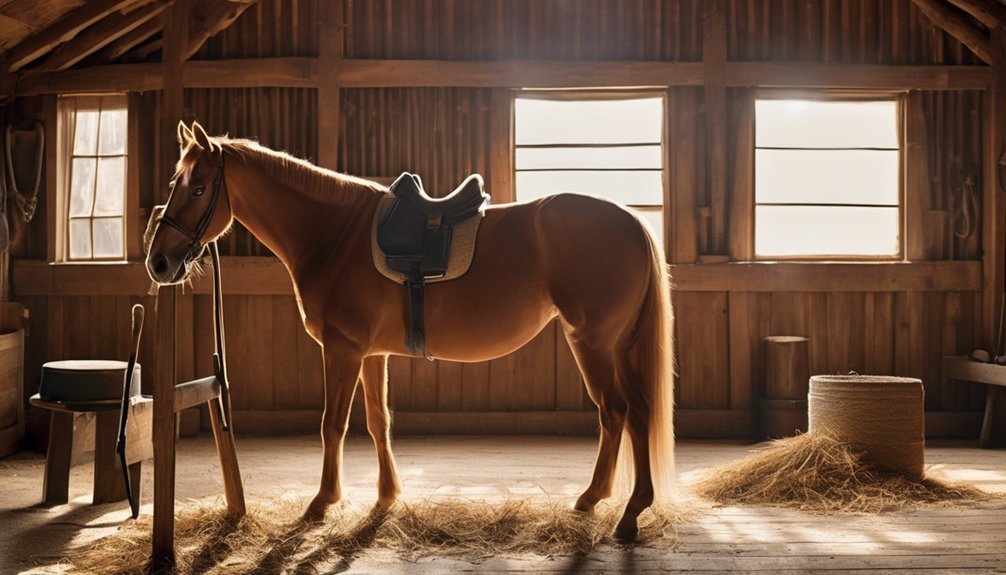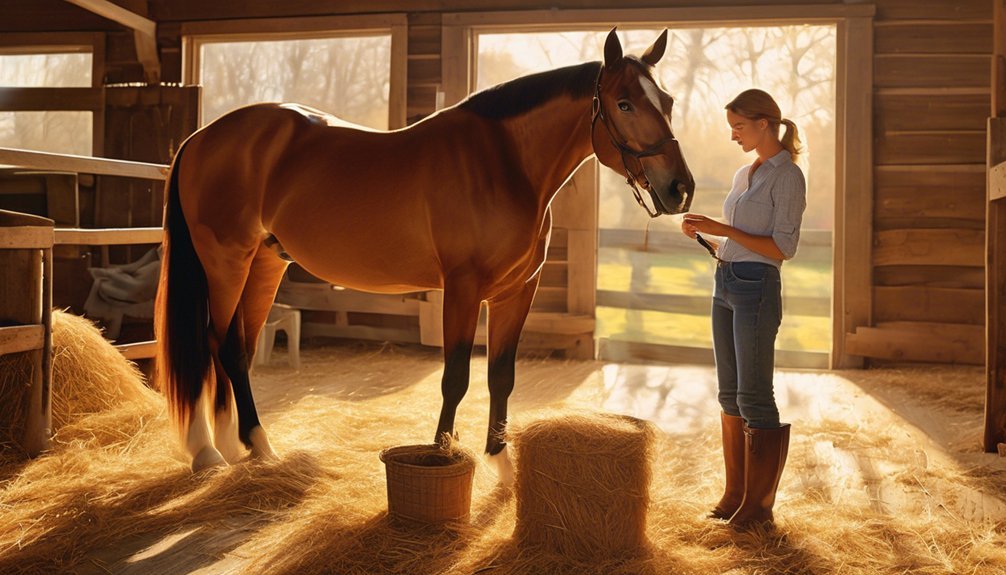
Creating a horse grooming routine requires careful consideration of your horse's unique needs. Start by assessing its coat type, activity level, and environment. Selecting the right tools is crucial for effective grooming. You'll want to establish a consistent schedule, adapting it to seasonal changes. As you develop this routine, remember the importance of gentle handling and building trust. Let's explore each aspect to ensure your grooming practice is both effective and enjoyable for you and your horse.
Key Takeaways
- Assess your horse's activity level, coat type, and environment to determine grooming frequency and needs.
- Gather essential grooming tools: curry comb, stiff brush, soft brush, hoof pick, and mane comb.
- Follow a step-by-step grooming process: curry, stiff brush, soft brush, hoof care, and mane/tail detangling.
- Adjust your grooming routine according to seasonal changes, addressing unique needs for winter, spring, summer, and fall.
- Avoid common mistakes by prioritizing hoof care, using gentle products, and maintaining a calm, patient grooming environment.
Understanding Your Horse's Grooming Needs

Understanding your horse's grooming needs is essential for maintaining their health and well-being. Regular grooming not only keeps your horse looking its best but also helps you monitor their skin condition and health.
The grooming frequency depends on factors like your horse's activity level, coat type, and environment. For instance, a horse in a muddy pasture might require daily grooming, while a stall-bound horse may need less.
Pay close attention to your horse's sensitivity; some areas, like the belly and legs, can be more reactive. Always approach grooming gently, using soft brushes to avoid causing discomfort.
Essential Grooming Tools and Supplies
To effectively groom your horse, you'll need a well-equipped toolkit that caters to their specific needs.
Start with basic grooming tools like a curry comb, which helps loosen dirt and hair, followed by a stiff brush to remove debris. A soft brush is essential for sensitive areas, while a hoof pick is crucial for maintaining healthy hooves.
Don't forget a mane and tail comb to prevent tangles and a sponge for washing their face. Additionally, having essential supplies like a grooming tote for organization and a sturdy water bucket for rinsing your tools can enhance your grooming routine.
Investing in high-quality grooming tools and essential supplies ensures your horse feels cared for and comfortable during each grooming session.
Step-by-Step Grooming Process

With your grooming tools at the ready, it's time to establish a structured grooming routine that keeps your horse looking and feeling great.
Start by brushing your horse with a curry comb to loosen dirt and hair, working from the neck down to the tail.
Follow with a stiff brush to remove the debris, paying special attention to areas prone to horse allergies, like the belly and legs.
Next, use a soft brush for sensitive areas, ensuring comfort.
Check hooves for stones and debris, cleaning them carefully.
Finally, finish with a mane and tail comb to detangle.
Aim for a grooming frequency that suits your horse's needs—daily for those prone to dirt buildup, and a few times a week for others.
Tailoring Your Routine to Different Seasons
As the seasons change, you'll want to adjust your grooming routine to accommodate your horse's needs.
In winter, focus on removing mud and debris, as wet conditions can lead to skin issues. Use a thicker coat conditioner to combat dryness.
In spring, your horse may shed more; employ a shedding blade to help manage this seasonal adjustment.
Pay attention to the weather considerations, as hot summer days require frequent bathing to keep your horse cool and comfortable.
Fall brings a shift in coat thickness—groom regularly to promote healthy growth.
Always keep your grooming tools clean and tailored for the season, ensuring each grooming session remains effective and enjoyable for both you and your horse.
Building a Bond Through Grooming

Grooming isn't just about keeping your horse clean; it's a powerful way to build a deeper connection with them. By incorporating specific bonding techniques into your grooming routine, you can enhance trust and understanding between you and your horse. Here's a quick overview of some grooming benefits:
| Bonding Technique | Benefit |
|---|---|
| Gentle brushing | Promotes relaxation |
| Slow, deliberate strokes | Builds trust |
| Talking softly | Creates a calming atmosphere |
| Regular routines | Establishes familiarity |
| Positive reinforcement | Encourages cooperation |
As you groom, pay attention to your horse's reactions. This attentiveness fosters intimacy, making your grooming sessions more than just a chore—they become cherished moments of connection.
Common Grooming Mistakes to Avoid
While establishing a grooming routine can enhance your bond with your horse, it's crucial to avoid common mistakes that could undermine this relationship. One major pitfall is neglecting hooves; regular hoof care is essential for your horse's overall health and comfort. Ignoring this aspect can lead to serious issues, so make it a priority.
Another mistake is using harsh products that can irritate your horse's skin or coat. Opt for gentle, natural grooming supplies that nourish rather than harm. Always test new products in small areas first to ensure they're suitable.
Finally, remember to stay patient and attentive throughout the grooming process, as rushing can create anxiety rather than foster trust. By avoiding these mistakes, you'll nurture a deeper connection with your horse.
Frequently Asked Questions
How Often Should I Groom My Horse?
You should groom your horse daily for optimal grooming frequency. This habit enhances your bond, improves circulation, and helps detect health issues early. Regular grooming benefits both you and your horse, fostering trust and well-being.
Can Grooming Help With My Horse's Behavior?
Imagine your horse, once skittish, becomes relaxed during grooming. Regular grooming not only strengthens your bond but also helps you recognize behavioral cues. These grooming benefits enhance trust, making your horse more responsive and calm overall.
What Should I Do if My Horse Dislikes Grooming?
If your horse dislikes grooming, try gentle grooming techniques tailored to their temperament. Start slowly, using soft brushes, and reward calm behavior. Gradually build trust, making grooming a positive experience to enhance your bond.
Is It Safe to Groom a Horse in Cold Weather?
Grooming in cold weather can be safe, but you should take cold weather precautions. Keep your horse warm, check for frostbite, and be mindful of their health considerations to ensure a comfortable grooming experience for both of you.
How Can I Tell if My Horse Enjoys Grooming?
To tell if your horse enjoys grooming, observe its body language. Relaxed ears, lowered head, and soft eyes indicate pleasure. Use gentle grooming tools, responding to its reactions, to foster a deeper bond during your sessions.
Conclusion
Creating a horse grooming routine is like weaving a tapestry; each thread contributes to a strong, trusting bond with your horse. By understanding your horse's unique needs and using the right tools, you can craft a personalized approach that adapts with the seasons. Remember, consistent grooming not only keeps your horse healthy and looking its best but also deepens your connection. So, embrace the process, and watch your relationship flourish like a well-tended garden.





